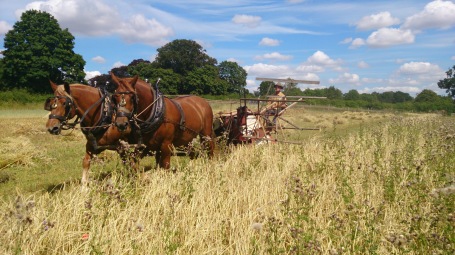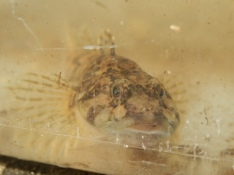It’s that time of year when you look out into the fields and you see combines going up and down harvesting the crops all day long. Well this is exactly what we have been doing down on the farm here at Gressenhall. The only difference is that we have been harvesting our crops using the Suffolk Punch horses with an Albion reaper binder. The crops on the farm this year have consisted of oats, rye and barley.
The workings and a bit of history behind the reaper binder:-
The reaper binder does not only cut the crop but also binds it into sheaves. The cut stems fall onto a bed canvas, which then transports it to two other elevator canvases which nip the harvested crop together whilst moving it to the binding mechanism. The binding mechanism bundles the crop and ties a piece of twine around the bundle. Once tied, it is ejected from the side of the binder.
Our binder is an Albion 5a and dates back to the 1940’s. It was produced by The Harrison McGregor Works at Leigh who were established in 1873 by Henry Harrison and Alexander McGregor. The ‘Albion’ range or harvest machinery achieved high sales and a high reputation around the world.
The binder is designed to be horse-drawn, but can be adapted for use with a tractor. The main drive of the machine is produced by a ‘bull wheel’ or ‘land wheel’. When the wheel turns, it drives a chain which then drives a gear box that transmits its power down driveshafts to make all aspects of the binder work.
The earliest models of binders used wire because the tying of the sheaf could be made with a simple twist rather than a complicated knot. But this did prove to have some disadvantages: it made it more difficult to cut the wire tie, and there was always the risk of damage through pieces of wire slipping through to the mechanism of a threshing machine.
The automatic knotting (binding) mechanism for twine was developed in America during the 1860s. Binders using the device did not immediately become popular because the twine used was relatively scarce and costly. This changed during the 1880s as the volume of production in Mexico of twine, made from sisal hemp, became available. This meant that the twine tying binders quickly took over from the wire variety.
The picture above shows the binder at work on a crop of Chevallier barley, a Victorian variety. From the seat the operator has a good view of the knotter and can regulate where the sheave is tied depending on the size of the crop. You can also see that our binder is a left hand cut, the size of the cutter bar is 5 foot and the sheaves are ejected from the right hand side. Another worker or two then follow up behind the binder stooking the sheaves in the field. This aids in the drying out of the cut crop.
Now that the harvest is complete for this year, we can now look ahead to see what crops will go where and then start the preparation of the land. I cannot wait to learn all about ploughing with the horses!
Ben Preston – Heritage Farming Apprentice














